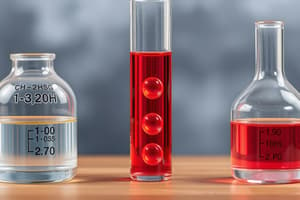Podcast
Questions and Answers
Number the steps for balancing equations:
Number the steps for balancing equations:
Use coefficients to increase the atoms on each side. = 3 Check to make sure you have the same number of each type of atom on each side. = 4 Count the atoms on each side. = 2 Identify the atoms on each side. = 1
Fill in the coefficients for the equation: Li2O + H2O + LiOH
Fill in the coefficients for the equation: Li2O + H2O + LiOH
- 2, 1, 1
- 0, 0, 0
- 1, 2, 1
- 1, 1, 2 (correct)
Fill in the coefficients for the equation: H2O + H2 + O2
Fill in the coefficients for the equation: H2O + H2 + O2
- 1, 2, 2
- 3, 2, 3
- 1, 1, 1
- 2, 2, 1 (correct)
Fill in the coefficients for the equation: Na2HPO4 + Na4P2O7 + H2O
Fill in the coefficients for the equation: Na2HPO4 + Na4P2O7 + H2O
Why do chemical equations have to be balanced?
Why do chemical equations have to be balanced?
Fill in the coefficients for the equation: CaSO4 → O2 + CaS
Fill in the coefficients for the equation: CaSO4 → O2 + CaS
Fill in the coefficients for the equation: BaO2 + H2SO4 → H2O2 + BaSO4
Fill in the coefficients for the equation: BaO2 + H2SO4 → H2O2 + BaSO4
Fill in the coefficients for the equation: O2 → O3
Fill in the coefficients for the equation: O2 → O3
Fill in the coefficients for the equation: Zn + HCl → ZnCl2 + H2
Fill in the coefficients for the equation: Zn + HCl → ZnCl2 + H2
Flashcards are hidden until you start studying
Study Notes
Balancing Chemical Equations Steps
- Steps to balance equations include identifying atoms, counting their quantities, verifying equality, and using coefficients for adjustment.
- Sequence of steps: Identify, Count, Check, Use Coefficients.
Coefficients for Specific Reactions
- For the reaction of lithium oxide with water to produce lithium hydroxide, the balanced coefficients are 1 for Li2O, 1 for H2O, and 2 for LiOH.
- In the reaction of water, hydrogen, and oxygen, balanced coefficients are 2 for H2O, 2 for H2, and 1 for O2.
- In balancing sodium phosphate, coefficients required are 2 for Na2HPO4, 1 for Na4P2O7, and 1 for H2O.
- For the reaction of calcium sulfate decomposing, the balanced coefficients are 1 for CaSO4, 2 for O2, and 1 for CaS.
- In the reaction of barium peroxide with sulfuric acid yielding water and barium sulfate, coefficients needed are all 1.
- To balance the reaction forming ozone from oxygen, the required coefficients are 3 for O2 and 2 for O3.
- For the reaction of zinc with hydrochloric acid producing zinc chloride and hydrogen, coefficients are 1 for Zn, 2 for HCl, 1 for ZnCl2, and 1 for H2.
Importance of Balancing Chemical Equations
- Balancing chemical equations is essential to adhere to the law of conservation of mass, which states that atoms are neither created nor destroyed in a chemical reaction.
- Equal number of atoms for each element must be maintained on both sides of the equation to accurately represent mass conservation.
Studying That Suits You
Use AI to generate personalized quizzes and flashcards to suit your learning preferences.




